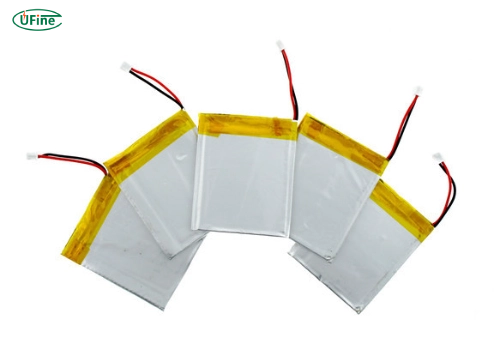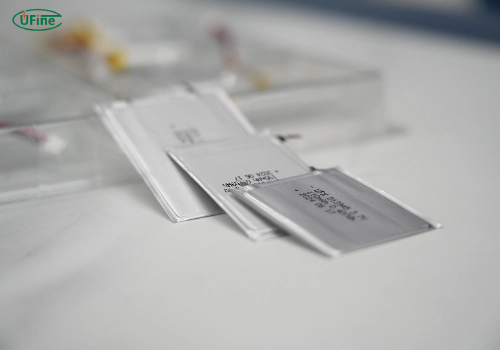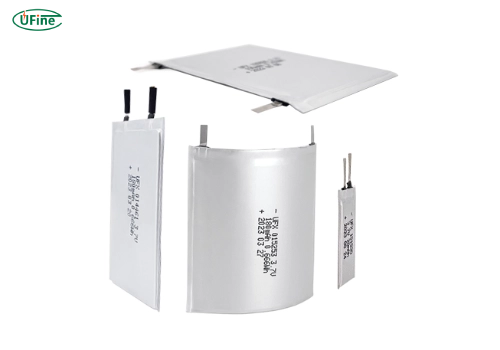Lithium-ion batteries have revolutionized the world of energy storage, powering everything from smartphones to electric vehicles. Among the various forms these batteries take, flat lithium-ion batteries stand out due to their unique design and versatility. This article delves into the anatomy, advantages, limitations, types, applications, charging technologies, and safety considerations of flat lithium-ion batteries.
Part 1. Anatomy of a flat lithium-ion battery
Flat Lithium Ion Battery Performance Characteristics
Flat lithium-ion or lithium polymer batteries offer high energy density, are lightweight, and provide flexibility. They offer a specific energy of 100–265 Wh/kg and an energy density of 250–693 Wh/L, making them ideal for compact and portable applications. Their charge/discharge efficiency ranges from 80% to 90%, and they typically have a nominal cell voltage of 3.6 to 3.85 V.
Flat Lithium Ion Battery Components and structure
A flat lithium-ion battery consists of several key components:
- Anode: Typically made of graphite, it stores lithium ions during charging.
- Cathode: Made of lithium metal oxides, it releases lithium ions during discharge.
- Separator: A porous membrane that prevents short circuits by keeping the anode and cathode apart.
- Electrolyte: A lithium salt solution that facilitates the movement of ions between the anode and cathode.
- Current Collectors: Positive and negative terminals that connect the battery to the external circuit.
Comparison with cylindrical and prismatic cells
Flat lithium-ion batteries differ significantly from cylindrical and prismatic cells in terms of design and application:
- Cylindrical cells: Manufacturers commonly use cylindrical cells in power tools and electric vehicles due to their robustness and ease of manufacturing.
- Prismatic cells: Designers often use them in electric vehicles and energy storage systems because they are more extensive and efficient in space utilization.
- Flat cells Offer the highest gravimetric energy density. They are ideal for applications where space and weight are critical, such as smartphones and drones.
Part 2. Advantages and limitations of flat lithium-ion batteries
Advantages
- High energy density: Provides more power in a smaller footprint.
- Lightweight: Reduces the overall weight of the device.
- Flexible design: Can be shaped to fit various device configurations.
- Low self-discharge rate: Retains charge longer when not in use.
- Fast charging: This can be charged quickly with appropriate technology.
Limitations
- Cost: Generally more expensive to produce than cylindrical or prismatic cells.
- Durability: Their thin and flexible nature makes them more susceptible to physical damage.
- Thermal management: Requires effective cooling systems to prevent overheating.
- Limited cycle life: Typically, they have a shorter lifespan than other cell types.
Part 3. Types of flat lithium-ion batteries
Flat lithium-ion batteries come in various chemistries, each with its own set of characteristics:
- Lithium Cobalt Oxide (LiCoO2): High energy density but limited lifespan and safety concerns.
- Lithium Manganese Oxide (LiMn2O4): Better thermal stability and safety but lower energy density.
- Lithium Iron Phosphate (LiFePO4): Excellent safety and lifespan but lower energy density.
- Lithium Nickel Manganese Cobalt Oxide (NMC): Balanced performance with good energy density, lifespan, and safety.
Part 4. Applications of flat lithium-ion batteries
Various industries use flat lithium-ion batteries in different applications due to their versatility.
- Consumer electronics: Smartphones, tablets, and laptops benefit from their compact size and high energy density.
- Wearable devices: Fitness trackers and smartwatches utilize their lightweight and flexible design.
- Drones: Drones provide the necessary power without adding significant weight.
- Medical devices: Manufacturers use these in portable medical equipment due to their reliability and safety.
- Electric vehicles: Engineers use these in specific configurations where space optimization is crucial, though they are rare.
Part 5. Charging technologies for flat lithium-ion batteries
Constant Current/Constant Voltage (CC-CV) method
The most common charging method for flat lithium-ion batteries is the CC-CV method. It involves two stages:
- Constant Current (CC): The battery is charged at a constant current until it reaches a specific voltage.
- Constant Voltage (CV): The voltage remains steady while the current gradually decreases until the battery reaches full charge.
Fast charging technologies
- Recent advancements have led to the development of fast charging technologies that can significantly reduce charging times. These technologies often involve higher currents and advanced thermal management systems to ensure safety and efficiency.
Part 6. Flat lithium-ion battery safety considerations
Safety is a critical concern with flat lithium-ion batteries due to their high energy density and potential for thermal runaway. Essential safety measures include:
- Battery Management Systems (BMS) Monitor and control the charging and discharging process to prevent overcharging, deep discharging, and overheating.
- Thermal management: Incorporates cooling systems to dissipate heat and maintain optimal operating temperatures.
- Protective casing: Ensures physical protection against impacts and punctures.
- Safety circuits include overcurrent protection, short circuit protection, and temperature sensors.
Part 7. FAQs
-
What is the typical lifespan of a flat lithium-ion battery?
The typical lifespan of a flat lithium-ion battery ranges from 300 to 500 charge cycles, which translates to about 2-3 years of regular use. This lifespan can vary based on usage patterns, charging habits, and environmental conditions. -
Can flat lithium-ion batteries be recycled?
Yes, flat lithium-ion batteries can be recycled. Recycling involves recovering valuable materials such as cobalt, nickel, and lithium. Proper disposal through authorized recycling centers is crucial to ensure environmental safety. -
How does temperature affect the performance of flat lithium-ion batteries?
Temperature significantly impacts the performance of flat lithium-ion batteries. Extreme cold can reduce capacity and discharge rate, while high temperatures can accelerate degradation and pose safety risks. The optimal operating temperature range is typically between 20°C to 35°C (68°F to 95°F). -
Are there any emerging technologies that could replace flat lithium-ion batteries?
Emerging technologies like solid-state, lithium-sulfur, and sodium-ion batteries show promise as potential replacements. These alternatives aim to offer higher energy density, improved safety, or lower costs. However, flat lithium-ion batteries will likely remain dominant shortly due to their established manufacturing processes and broad adoption. -
How do manufacturers ensure the quality and safety of flat lithium-ion batteries?
Manufacturers ensure the quality and safety of flat lithium-ion batteries through rigorous testing at each production stage, X-ray inspections to detect internal defects, automated assembly processes to minimize human error, and strict adherence to international safety standards. These measures help maintain high standards of reliability and safety.
Related Tags:
More Articles

LiPo Battery Discharge Rate Guide & Calculation Tips
Understand LiPo battery discharge rates, C-ratings, and how to calculate max current. Essential guide for RC, drones, and electronics users.
High‑Capacity 3S LiPo Batteries: 5000 mAh vs. 10000 mAh
Compare 3S LiPo 5000mAh vs 10000mAh batteries by weight, power, and use. Find the best fit for your drone, RC car, or boat setup.
Top 5 Applications for Small 3S LiPo Batteries
Small 3S LiPo batteries power drones, RC gear, wearables, and robotics with high energy and low weight. Making them ideal for compact electronics projects.
Building and Charging Your Own 3S LiPo Pack: A Step‑by‑Step Guide
Learn how to build, balance, and charge a 3S LiPo battery pack safely at home with this complete DIY guide for hobbyists and beginners.
How to Choose the Right LiPo Battery Plug Type?
Discover the best LiPo battery plug types, how to choose them, and expert tips for safe usage, soldering, and maintenance.






